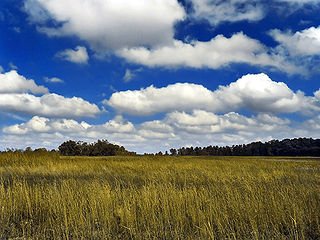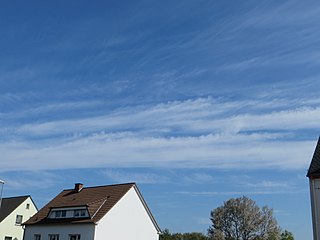
Cirrus is a genus of high cloud made of ice crystals. Cirrus clouds typically appear delicate and wispy with white strands. In the Earth's atmosphere, cirrus are usually formed when warm, dry air rises, causing water vapor deposition onto mineral dust and metallic particles at high altitudes. Globally, they form anywhere between 4,000 and 20,000 meters above sea level, with the higher elevations usually in the tropics and the lower elevations in more polar regions.

In meteorology, a cloud is an aerosol consisting of a visible mass of miniature liquid droplets, frozen crystals, or other particles suspended in the atmosphere of a planetary body or similar space. Water or various other chemicals may compose the droplets and crystals. On Earth, clouds are formed as a result of saturation of the air when it is cooled to its dew point, or when it gains sufficient moisture from an adjacent source to raise the dew point to the ambient temperature.

Cumulus clouds are clouds that have flat bases and are often described as puffy, cotton-like, or fluffy in appearance. Their name derives from the Latin cumulus, meaning "heap" or "pile". Cumulus clouds are low-level clouds, generally less than 2,000 m (6,600 ft) in altitude unless they are the more vertical cumulus congestus form. Cumulus clouds may appear by themselves, in lines, or in clusters.

Altocumulus is a middle-altitude cloud genus that belongs mainly to the stratocumuliform physical category, characterized by globular masses or rolls in layers or patches – the individual elements being larger and darker than those of cirrocumulus and smaller than those of stratocumulus. However, if the layers become tufted in appearance due to increased airmass instability, then the altocumulus clouds become more purely cumuliform in structure. Like other cumuliform and stratocumuliform clouds, altocumulus signifies convection. A sheet of partially conjoined altocumulus perlucidus is sometimes found preceding a weakening warm front, where the altostratus is starting to fragment, resulting in patches of altocumulus perlucidus between the areas of altostratus. Altocumulus is also commonly found between the warm and cold fronts in a depression, although this is often hidden by lower clouds.

A stratocumulus cloud, occasionally called a cumulostratus, belongs to a genus-type of clouds characterized by large dark, rounded masses, usually in groups, lines, or waves, the individual elements being larger than those in altocumulus, and the whole being at a lower height, usually below 2,000 metres (6,600 ft). Weak convective currents create shallow cloud layers because of drier, stable air above preventing continued vertical development. Historically, in English, this type of cloud has been referred to as a twain cloud for being a combination of two types of clouds.

Cirrocumulus is one of the three main genus types of high-altitude tropospheric clouds, the other two being cirrus and cirrostratus. They usually occur at an altitude of 5 to 12 km, however they can occur as low as 10,000 ft (3.0 km) in the arctic and weather reporting standards such as the Canadian MANOBS suggests heights of 29,000 ft (8.8 km) in summer and 26,000 ft (7.9 km) in winter. Like lower-altitude cumuliform and stratocumuliform clouds, cirrocumulus signifies convection. Unlike other high-altitude tropospheric clouds like cirrus and cirrostratus, cirrocumulus includes a small amount of liquid water droplets, although these are in a supercooled state. Ice crystals are the predominant component, and typically, the ice crystals cause the supercooled water drops in the cloud to rapidly freeze, transforming the cirrocumulus into cirrostratus. This process can also produce precipitation in the form of a virga consisting of ice or snow. Thus, cirrocumulus clouds are usually short-lived. They usually only form as part of a short-lived transitional phase within an area of cirrus clouds and can also form briefly as a result of the breaking up of part of a cumulonimbus anvil.

Cirrocumulus undulatus is a variety of cirrocumulus cloud. The name cirrocumulus undulatus is derived from Latin, meaning "diversified as with waves". They have a rippled appearance due to wind shear and usually cover only a small portion of the sky. They appear in bands as small patches or layers. Occasionally, they comprise two or more wave forms superposed upon one another. The individual cloudlets can either be circular or elongated in the direction of the rows.

Cirrus castellanus or Cirrus castellatus is a species of cirrus cloud. Its name comes from the word castellanus, which means of a fort, of a castle in Latin. Like all cirrus, this species occurs at high altitudes. It appears as separate turrets rising from a lower-level cloud base. Often these cloud turrets form in lines, and they can be taller than they are wide. This cloud species is usually dense in formation.

Cirrus intortus is a variety of cirrus cloud. The name cirrus intortus is derived from Latin, meaning "twisted, wound". The variety of intortus clouds is specific to cirrus clouds, and they appear as interwound strands of cirrus clouds with a purely random pattern. The filaments are often curved in a very irregular pattern.

Cirrus fibratus or also called Cirrus filosus is a species of cirrus cloud. The name cirrus fibratus is derived from Latin, meaning "fibrous". These clouds are similar to cirrus uncinus, commonly known as "mares' tails"; however, fibratus clouds do not have tufts or hooks at the end. The filaments are usually separate from one another.

Cirrus floccus is a type of cirrus cloud. The name cirrus floccus is derived from Latin, meaning "a lock of wool". Cirrus floccus occurs as small tufts of cloud, usually with a ragged base. The cloud can have virga falling from it, but the precipitation does not reach the ground. The individual tufts are usually isolated from each other. At formation, the cirrus floccus clouds are bright white and can be mistaken for altocumulus clouds; however, after a few minutes, the brightness begins to fade, indicating they are made up of pure ice, and are therefore at a higher level.

Cirrus radiatus is a variety of cirrus cloud. The name cirrus radiatus is derived from Latin, meaning "rayed, striped". This variety of cirrus clouds occurs in parallel bands that often cover the entire sky and appear to converge at a single point or two opposite points on the horizon. Cirrus radiatus is often partly made up of cirrocumulus or cirrostratus.

Cirrocumulus castellanus or Cirrocumulus castellatus is a type of cirrocumulus cloud. Castellanus is from the Latin meaning "of a castle". These clouds appear as round turrets that are rising from either a lowered line or sheet of clouds. Cirrocumulus castellanus is an indicator of atmospheric instability at the level of the cloud. The clouds form when condensation occurs in the base cloud, causing latent heating to occur. This causes air to rise from the base cloud, and if the air ascends into conditionally unstable air, cirrocumulus castellanus will form.

Cirrocumulus lenticularis is a type of cirrocumulus cloud. The name cirrocumulus lenticularis is derived from Latin, meaning "like a lentil". Cirrocumulus lenticularis are smooth clouds that have the appearance of a lens or an almond. They usually form at the crests of atmospheric waves, which would otherwise be invisible. This species of cirrocumulus can often be quite elongated and normally has very distinguished boundaries. Cirrocumulus lenticularis forms when stable air is forced upward; this is usually due to orographic features, but can occur away from mountains as well. Irisation can occasionally occur with these clouds.

Cirrocumulus stratiformis is a type of cirrocumulus cloud. The name cirrocumulus stratiformis is derived from Latin, meaning "stretched out". Cirrocumulus stratiformis occurs as very small cirrocumulus clouds that cover a large part of the sky. This type of cloud always occurs in thin layers. There can be spaces or rifts between the individual cloudlets in the layer.

A castellanus, or castellatus, is a cloud that displays at least in its upper part cumuliform protuberances having the shape of turrets that give a crenellated aspect. Some of these turrets are higher than they are wide; they have a common base and seem to be arranged in a line. The castellanus characteristic is particularly obvious when the clouds are observed from the side.

Altocumulus floccus is a cloud type named for its tuft-like, wooly appearance. The base of the cloud can form as low as 2,000 metres (6,600 ft), or as high as 6,000 metres (20,000 ft). They often form in clusters, or patches, and bases can vary in height with differing atmospheric conditions within the PBL. They are similar to Altocumulus castellanus, but often have a shallower vertical extent in comparison.

Stratocumulus castellanus or Stratocumulus castellatus is a type of stratocumulus cloud, castellanus is derived from Latin, meaning 'of a castle' This type of cloud appears as cumuliform turrets vertically rising from a common horizontal cloud base, these turrets are taller than they are wide


















